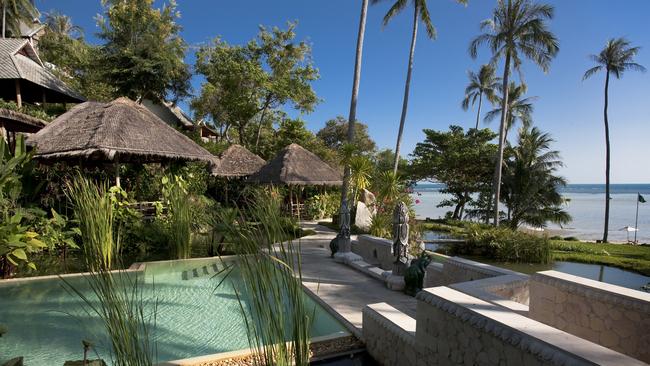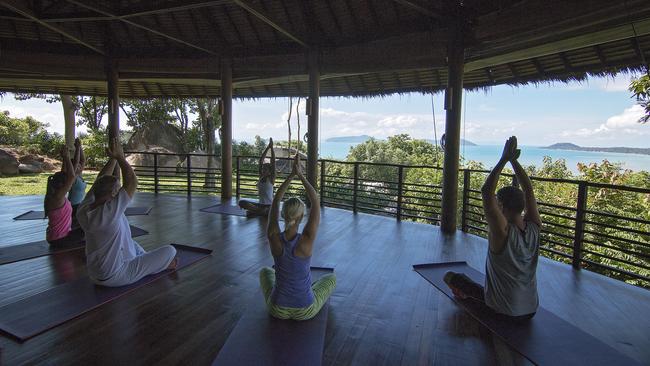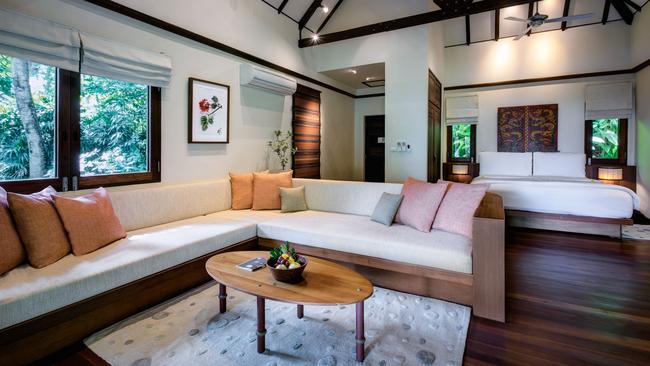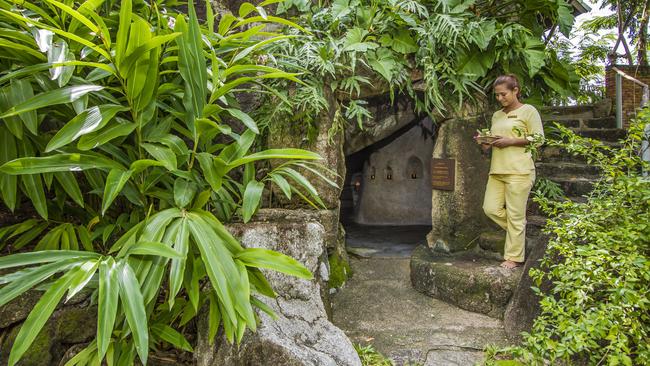Well, well, well at Kamalaya resort
Peace reigns at a Thai health resort.

It seems entirely appropriate that the first thing I eat during my inaugural stay at a wellness resort is a lotus petal. It is delivered to my dining table as an amuse bouche delicately poised on a ceramic spoon and filled with a crunchy concoction of fruit, prawn and seeds.
Over the next five days, wrapped in a holistic-health cocoon, not only will I eat these pretty pink petals, but I will swim beside fish ponds blooming with lotus and I will assume the position named for them, legs crossed, hands resting on my knees, thumb and forefinger lightly touching, while attempting to quieten my mind. Even the name of this resort, Kamalaya, translates as “lotus realm”.
The property, on the Thai island of Koh Samui, is perched on a steep hillside covered in gardens abundant with ferns, bougainvillea, frangipani and hibiscus. A man-made creek tumbles down the gully, creating a constant soundtrack of running water punctuated by the chitter-chatter of birds and the amiable click of geckos. The architecture, by Australia’s Robert Powell, celebrates the site’s natural features, embracing the round granite boulders that sprout like giant mushrooms.

At the foot of the hill lies a coconut palm-crested lagoon. Low tide sees ankle-deep water stretch for hundreds of metres before dropping off into the deep. It’s not the most inviting of swimming spots but I’m not here for a beach holiday; I’m here for a big dose of wellness — specifically, to be “structurally revived”.
The program I’ve been assigned aims to de-knot my neck and shoulders, relieve tension and pain (get ready, lower back), realign my body and improve my posture through a combination of massage, pilates, stretching and physiotherapy. Along the way, there’s the chance for yoga, meditation, qi gong, aqua aerobics and lessons in pranayama breathing.
First, though, I have to be assessed. The Wellness Centre, an airy timber pavilion with polished concrete floors and wide ocean views, feels hushed and reverent. I’m ushered into a room where my vital statistics are measured — weight, height and blood pressure. I also undergo a test called bioelectrical impedance analysis, which sends a weak electric signal through the body to assess body fat, muscle mass and fluid levels.
Afterwards I return to the reception area to prepare for my fate, feeling like a criminal awaiting their sentence. Fortunately, Leila, a naturopath from Britain, has good news. All the numbers add up for a woman of my age; I’m actually in pretty good nick. My shoulders, back and neck beg to differ, however, and I’m packed off to the physio.

The structural revival program is one of 10 that Kamalaya guests can choose, covering everything from fitness, yoga, weight loss and sleep enhancement to more esoteric topics such as “embracing change” and a “balance and revitalise” option to tackle burnout and stress. One-on-one mentoring is offered by counsellors who have spent a minimum 10 years as monks in India.
Of course, you could stay at Kamalaya and simply loll by the pool. But about 80 per cent of guests, most of whom hail from Europe, with about 15 per cent from Australia and New Zealand, opt to go on a program. And regardless of which regimen they’re adhering to, almost everyone I meet is detoxing. I decide to give it a shot too, but with one extra shot — I’ll allow myself a latte every morning.
Apart from that one concession, off the menu are dairy, wheat, corn, capsicum, tomato, eggplant, potato, nuts, gluten and sugar. Because of the amount of exercise I’ll be doing, and given the geography of the place, I can’t even leave my villa without climbing that hill, I’m allowed 100g of protein with lunch and dinner. Oh, and there’s no alcohol (although it’s available should you choose to fall off the wagon). Leila, bless her, has given me permission to drink coconut juice, due to its electrolyte properties. These prove more refreshing than a G&T in the heat.

I’ve been apprehensive about how much deprivation will have to be endured but my fears are quickly assuaged at Soma restaurant. This two-level shrine to healthy eating looks out over the lagoon, and the food is abundant and delicious. I dine on daikon radish cake topped with crispy shoots; kimchi pancake floating in a vivid pool of beetroot; a divine mushroom saagwala; and a banana flower salad that oozes goodness. The breakfast buffet has as much variety as a mainstream hotel’s, minus the Coco Pops and bacon. Instead, we throw down tonic shots of turmeric and kale, and load plates with fresh fruit. I’m soon addicted to the sweet potato bread smeared with seed butter, and by the end of my stay think nothing of loading up a bowl with salad at 8am.
Another form of detox proves more challenging. A sign on each dining table gently requests guests refrain from using the go-to social crutch of singleton diners — phones and tablets. It takes a day or two to adjust, but gradually the need to be constantly occupied abates. There’s that gorgeous view to contemplate, after all, not to mention a schedule of activities to consider.
My program includes two pilates sessions and I begin to suspect it’s not my body that’s the problem; it’s my brain. The hitherto simple act of breathing in and out while following instructions to lift a leg here and make an “imprint” there proves challenging for an uncoordinated newbie. My instructors, Poon and Mew, deserve medals for their patience. Less difficult is the “super stretch” session, which involves me lying passively on a mat while Mew bends my arms and legs this way and that. I barely have to lift a finger yet emerge feeling limber and loose.
The fine line between pleasure and pain is crossed several times during a myofascial release massage, and again during a foot massage that begins with my feet soaking in a hot, fragrant soup of herbs, galangal and orchids. But my favourite form of torture, despite the discomfort inflicted by the merciless Sasi, is the traditional Thai therapeutic treatment. She hones in on trigger points around my scapula and treats my glutes with the disdain they deserve. Afterwards, I float off to the steam room in a daze that lifts only when I brave the ice-cold plunge pool.
When I’m not being pushed and pummelled, I lounge by one of two pools or head to the Shakti fitness centre, a spectacular semicircular gym with an enormous boulder incorporated into its design. My sea-view villa, a spacious open-plan haven with a lounge area and circular bathroom that reminds me of a beehive, offers blissful relief from the afternoon heat. Gradually, I feel my joints loosening, my shoulders relaxing. I walk taller, sleep early and long, and eat so cleanly there’s surely a halo visible above my head.
Meandering the paths in between meals and treatments, I’m struck by the peacefulness of Kamalaya. I occasionally pass another guest or exchange a “sawasdee ka” greeting with a smiling staff member floating by in their lemon cotton uniforms, but mostly my time is solitary. It feels indulgent to have so much “me” time, away from the usual demands of work and family.
Dinner presents a chance to connect with other guests at the (optional) communal dining table. My fellow wellness warriors cut across all walks of life. I meet a mining executive from Perth on her fifth visit to Kamalaya, which may explain her impossibly youthful looks; a Mexican woman who has offloaded her children to Swiss boarding school and is travelling alone for the first time; a German grandmother who is here for six weeks to tend the on-site shrine to an Indian yogi. And there’s a quartet of Aussie blokes on their fourth fitness-focused stay who definitely don’t match the stereotype of tree-hugging yoga aficionados. I fit the most common profile; solo women make up about 65 per cent of guests. But something happens when we sit down to dinner, dissecting the day’s activities and swapping detox menu tips. There’s a sense of camaraderie, and conversations quickly leap from the mundane to the personal. Somehow, we’re all in this wellness thing together.
Penny Hunter was a guest of Kamalaya.
-
In the know
Kamalaya is on the southeast corner of Koh Samui, about 25km from the airport. From 8500 baht ($390) a night, twin-share, for a minimum three-night stay, including daily holistic activities such as yoga, pilates, meditation and access to the fitness centre. The resort has four guestroom categories, ranging from hillside rooms with sea or garden views, to suites, villas and pool villas. The five-night Structural Revival program, including all treatments, holistic activities, full board, transfers and accommodation in an entry-level hillside garden-view room, starts from 91,473 baht ($4250), single occupancy.
-
More to the story

Spirituality is an important part of the Kamalaya ethos, but it’s not forced upon guests. At the heart of the property is a cave used for centuries by Buddhist monks as a place for meditation and retreat. The resort’s co-founder, John Stewart, stumbled upon it on a visit to Koh Samui in 2000. Suffering from ill health at the time, he was instantly convinced the land was where he and his wife, Karina, should build the wellness resort they had long dreamt about. John, from Canada, devoted 16 years to learning Eastern spiritual practices in the Indian Himalayas. Karina, an Ivy League graduate originally from Mexico, has a doctorate in traditional Chinese medicine. Together they wanted to combine their knowledge to promote physical, emotional, psychological and spiritual wellbeing through a mix of holistic medicine and complementary therapies from the East and West. Four years after their discovery, Kamalaya was born. Atmospherically lit by candles, the cave is open to guests at any time for quiet contemplation, and monks still make pilgrimages here. There are other places where you can nurture your spiritual side. Next to the Yantra Hall, where meditation sessions are conducted, is a carefully tended shrine to the late Indian holy man known as Babaji whom John studied under in India. Meanwhile, dotted around the resort grounds are numerous spirit houses, ornate roofed shrines designed to shelter guardian spirits under the animist belief system. But I find my spirit is happiest when I’m sprawled on the daybed on my balcony, soaking up the serenity while sipping a coconut juice.

To join the conversation, please log in. Don't have an account? Register
Join the conversation, you are commenting as Logout